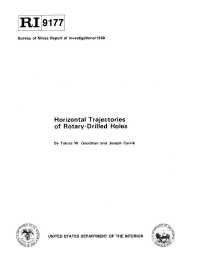Mining Publication: Horizontal Trajectories of Rotary-Drilled Holes
Original creation date: January 1988
This Bureau of Mines report investigates the horizontal trajectory of boreholes drilled in coalbeds using the rotary drilling technique. Test holes drilled in coalbeds showed that the path of a borehole in the horizontal plane depends on drilling assembly configuration, drill bit rotation, and coalbed geologic features. An assembly that contained an 18-ft (5.5-M) long drill collar and two centralizers had the best horizontal stability evidenced by trajectories that deviated less than 16 ft (4.9 m) from a target at 1,000 ft (305 m). Removal of one of the centralizers resulted in a loss of control of hole trajectory in the horizontal plane. Generally, holes tended to turn to the right, presumably because of right-hand rotation of the bit. Deviations from the original bearing line were as much as 200 ft (61 m) or more at a depth of 1,000 ft (305 m).
Authors: TW Goodman, J Cervik
Report of Investigations - January 1988
NIOSHTIC2 Number: 10006100
U.S. Department of the Interior, Bureau of Mines. Report of Investigations 9177, NTIS No. PB89-104087, 1988; :1-11
See Also
- Cableless Electronic Surveying Systems for Horizontal Holes
- Coal Mine Methane: A Review of Capture and Utilization Practices with Benefits to Mining Safety and to Greenhouse Gas Reduction
- Comparison of Rotary and In-Hole Motor Techniques for Drilling Horizontal Boreholes in Coal
- Correlation of Sonic Travel Time to the Uniaxial Compressive Strength of U.S. Coal Measure Rocks
- Demonstration of Remote Mine Seal Construction
- Detecting Strata Fracturing and Roof Failures from a Borehole Based Microseismic System
- Effects of Stimulation Treatments on Coalbeds and Surrounding Strata: Evidence from Underground Observations
- Removing Methane (Degasification) from the Pocahontas No. 4 Coalbed in Southern West Virginia
- Rotary Drilling Holes in Coalbeds for Degasification
- Use of Vertical Boreholes for Assisting Ventilation of Longwall Gob Areas
- Content source: National Institute for Occupational Safety and Health, Mining Program


 ShareCompartir
ShareCompartir
